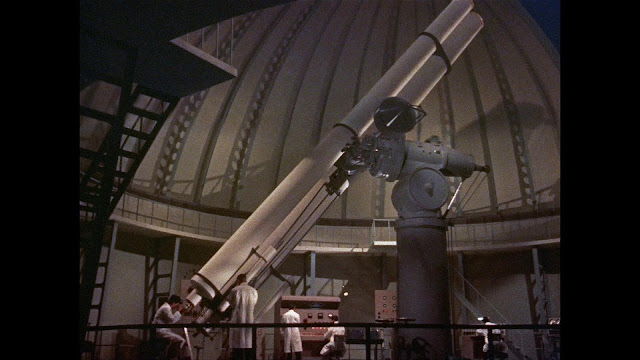THE APE (1940, Kino Lorber, 62m 50s): There has been a recent spate of books about Bela Lugosi's so-called "Monogram Nine" but we mustn't forget that, before the Poverty Row studio gave Bela a call, Boris Karloff was placed under contract for a half-dozen Monogrammers - welcome work at a time when the Hays Office was doing their best to discourage the production of horror pictures. All but one of Karloff's Monogram pictures were mystery programmers in which he was rather imaginatively cast as the Asian-American detective James Lee Wong. The last one was the ringer, taking a turn toward the sort of "Mad Doctor" thrillers that Karloff had been making for Columbia Pictures around the same time. This was THE APE, directed by William Nigh (the maestro behind all five Mr. Wong pictures) and scripted by Curt Siodmak, then fresh from scripting BLACK FRIDAY for both Karloff and Lugosi over at Universal.
Though I don't think it's technically public domain, THE APE has been included in numerous PD presentations on home video and it has tended to look every day of its age, taken from battered 16mm prints and worse. This also goes for Retromedia's "Double Feature" Blu-ray disc of THE APE and PRC's THE BLACK RAVEN with George Zucco, of which an Amazon reviewer noted: "The print for THE APE is not any better than a typical standard DVD release of a public domain movie." Kino Lorber's new Blu-ray disc, on the other hand, is sure to astonish anyone previously familiar with the film and its past presentational woes; it's a brand new 2K master taken from a nearly pristine British release print preserved by the Library of Congress. While not absolutely spotless, it's at least 97% so, and a pleasing rejuvenation of this cheerfully implausible 63m melodrama.
Karloff plays Dr. Bernard Adrian, a former scientific big shot who has retreated to a small town after being rejected by the medical association for experimenting on human subjects. Inspired by the plight of a polio-stricken young woman (Maris Wrixon) he's devoted to, he develops a spinal fluid serum that tests well on animals, so he takes the step of administering it to his human subject - with promising results. Unfortunately, said serum requires healthy spinal fluid from well people, who aren't likely to offer it willingly. In a simultaneous stroke of bad and good luck, a large gorilla escapes from a visiting circus, which breaks into Dr. Adrian's lab. He manages to kill it and (offscreen, of course) converts the carcass into an ape suit, which he dons before taking to the streets and juicing people's spines!
The idea is preposterous (the filmmakers seem cheerfully oblivious to this), the performances are competent and sometimes surprisingly sincere, and there's a charming, down-to-earth quality about the rustic, old-fashioned, small town setting with its muddle-headed elders, moon-faced young lovers, and obnoxious rock-throwing kids - and hey! There's an ape on the loose! With the film's newly restored gloss, it's now very obvious that the glass in the windows is some porto-form of Saran Wrap, but the ape (played by Ray "Crash" Corrigan) makes quite a good impression when he comes crashing through. An uncredited Philo McCullough is fun to loathe as the town's resident louse, and I. Stanford Jolley (one of my favorite bit players) turns up as the sadistic animal keeper at the circus, who gets to play a nice dramatic scene with Karloff.
KL has added collectable "oomph" to the package by adding not one, but two audio commentaries by the ever-reliable Tom Weaver and Richard Harland Smith, respectively. Both are informative and witty but distinctively different. Weaver scoffs at much of the film but his love for the picture comes through in his careful attention to props, detail, and in the way he traces stock footage to its point of origin; he even traces the shingle outside Dr. Adrian's abode to its recycling in a later Monogram picture. Smith, on the other hand, takes a somewhat warmer, more humanistic approach, appreciating the movie on its own terms and showing particular attention to the players, not only their lives but their times. Both commentators point out little Buddy Swan as one of the neighborhood brats - his immortality as the young Charles Foster Kane in CITIZEN KANE came the following year - but I can't think of too many other points of redundancy. One can only wish that Olive Films' releases of VOODOO MAN and RETURN OF THE APE MAN had this kind of enthusiastic supplemental support.
(c) 2020 by Tim Lucas. All rights reserved.
Subscribe to Tim Lucas / Video WatchBlog by Email
If you enjoy Video WatchBlog, your kind support will help to ensure its continued frequency and broader reach of coverage.










































